
The Cyclades are an island group in the Aegean Sea, southeast of mainland Greece and a former administrative prefecture of Greece. They are one of the island groups which constitute the Aegean archipelago. The name refers to the archipelago forming a circle around the sacred island of Delos. The largest island of the Cyclades is Naxos, however the most populated is Syros.
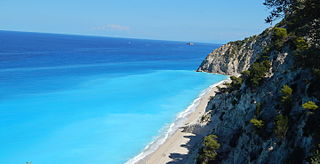
Tourism in Greece has been a key element of the economic activity in the country, and is one of the country's most important sectors. Greece has been a major tourist destination and attraction in Europe since the 1970s for its rich culture and history, which is reflected in large part by its 18 UNESCO World Heritage Sites, among the most in Europe and the world as well as for its long coastline, many islands, and beaches.

Milos or Melos is a volcanic Greek island in the Aegean Sea, just north of the Sea of Crete. Milos is the southwestern-most island in the Cyclades group.
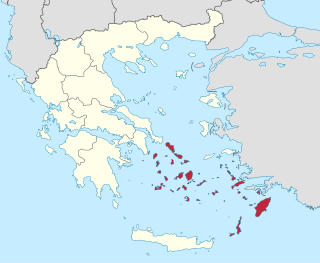
The South Aegean is one of the thirteen administrative regions of Greece. It consists of the Cyclades and Dodecanese island groups in the central and southeastern Aegean Sea.
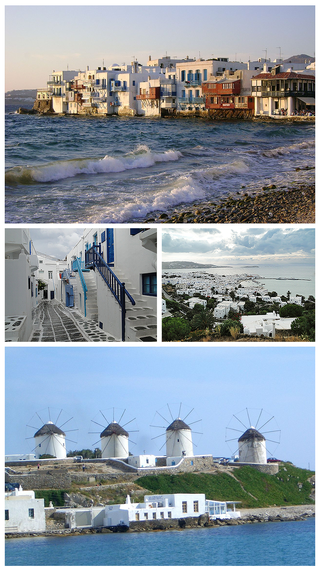
Mykonos is a Greek island, part of the Cyclades, lying between Tinos, Syros, Paros and Naxos. The island has an area of 85.5 square kilometres (33.0 sq mi) and rises to an elevation of 341 metres at its highest point. At the 2021 census, there were 10,704 inhabitants, most of whom lived in the largest town, Mykonos, which is on the west coast. The town is also known as Chora.

The Saronic Islands or Argo-Saronic Islands is an archipelago in Greece, named after the Saronic Gulf in which they are located, just off the Greek mainland. The main inhabited islands of this group are Salamis, Aegina, Agistri, and Poros. The islands of Hydra and Dokos, which lie off the northeast tip of the Peloponnese, are sometimes included as part of the Saronic Islands.
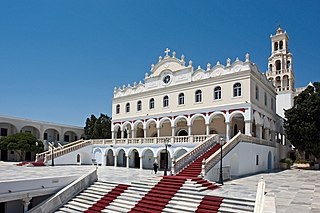
Tinos is a Greek island situated in the Aegean Sea. It is part of the Cyclades archipelago. The closest islands are Andros, Delos, and Mykonos. It has a land area of 194.464 square kilometres (75.083 sq mi) and a 2021 census population of 8,934 inhabitants.

Donousa, and sometimes spelled Donoussa, is an island and a former community in the Cyclades, Greece. Since the 2011 local government reform it is part of the municipality Naxos and Lesser Cyclades, of which it is a municipal unit. Donousa is the easternmost island of the Lesser Cyclades.

Lixouri is a town and a municipality in the island of Kefalonia, the largest of the Ionian Islands of western Greece. It is the main town on the peninsula of Paliki, and the second largest town in Kefalonia after Argostoli and before Sami. It is located south of Fiskardo and west of Argostoli. Since the 2019 local government reform it is one of the three municipalities on the island. It has one municipal unit that is coterminous with the municipality: Paliki.
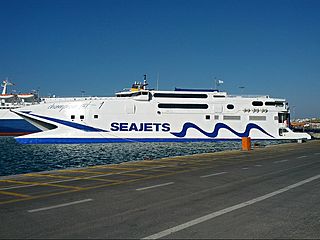
The HSC Champion Jet 1 is an 86m fast catamaran ferry operated by Seajets Ferries. She was until early 2015 owned by Condor Ferries and called HSC Condor Vitesse.

Manto Mavrogenous was a Greek princess and heroine of the Greek War of Independence. An extremely wealthy aristocrat, she contributed her fortune for the Hellenic cause. Under her encouragement, her aristocratic European friends contributed money and guns to the revolution.

Elati is a mountain on the Greek island of Lefkada. It is the island's highest peak.

Mykonos-Manto Mavrogenous Airport is the international airport of the Greek island of Mykonos, located 4 kilometres (2.5 mi) from the town of Mykonos. It serves flights to domestic and European metropolitan destinations due to the island being a popular leisure destination.

The Archaeological Museum of Delos is a museum on the island of Delos, near Mykonos in the South Aegean, Greece. It is noted for its extensive collection of statues unearthed in the surrounding area of the ancient site, which has been declared a UNESCO World Heritage Site. Although the museum has a considerable collection, it does not contain all of the items found in Delos: a large quantity are on display in Athens at the National Archaeological Museum.

Wog Boy 2: Kings of Mykonos is a 2010 Australian comedy film directed by Peter Andrikidis, starring Nick Giannopoulos, Vince Colosimo and Costas Kilias. It is the second part of the Wog Boy trilogy, succeeding The Wog Boy (2000) and preceding Wog Boys Forever (2022). It was released in Australia on 20 May 2010 and UK on 7 January 2011. The film received negative reviews.
Petros, the original Greek version of the name Peter, meaning "stone" or "rock". Also an Armenian and Coptic name. May refer to:

KTEL is the main intercity public transport bus service in Greece. It is a cooperation of 62 regional bus companies on the mainland of Greece and its islands. KTEL was founded in 1952, and the combined KTEL fleet numbers 4,199 buses as of 2023.
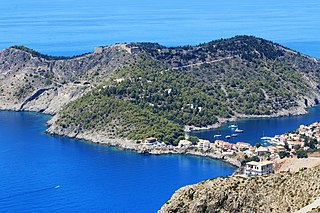
The Assos Castle is a Venetian fortification on Cephalonia island in western Greece.
Petros-Charalampos Melissaratos is a Greek professional basketball player for Mykonos of the Greek A2 Elite League. He is a 2.06 m (6'9") tall center.

Christodoulos Kalergis, also known as Christodoulos Kallergis. He is one of the few Greek painters that were not from Crete or the Ionian Islands. He was from the Cyclades. He was active on the island of Mykonos and the Peloponnese Region. He is a member of the Neo-Hellenikos Diafotismos in art and the Greek Rococo period. Emmanuel Skordilis brought the art of Crete to the Cyclades. He influenced Kalergis and other local artists. Kalergis's most notable piece is the Virgin and Child. His art resembles a mixture of late Byzantine art and the Venetian influenced maniera greca. Ten of his paintings and four frescos have survived. Around the period, another famous artist Nikolaos Kallergis shared the same last name.



















